Table of Contents
Bayrocin, also known as Enrofloxacin, is an antibiotic medication that belongs to the fluoroquinolone class of drugs. It is primarily used in veterinary medicine to treat bacterial infections in animals, particularly dogs and cats.
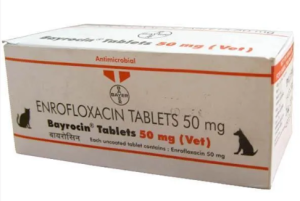
What Is Bayrocin (Enrofloxacin)?
Enrofloxacin works by inhibiting the enzymes necessary for bacterial DNA synthesis, thus preventing the growth and replication of bacteria. It is effective against a wide range of gram-negative and some gram-positive bacteria, including those that cause respiratory, urinary tract, skin, and gastrointestinal infections in animals.
It’s important to note that Bayrocin (Enrofloxacin) is intended for veterinary use only and should not be used in humans. The use of Enrofloxacin in humans has been limited due to potential side effects and concerns about the development of antibiotic resistance.
Who Makes the Drug?
The manufacturer of Bayrocin (Enrofloxacin) is Bayer Pharmaceuticals Pvt Ltd. It is a pharmaceutical company known for making a lot of widespread medicines. The company started many years ago and is now one of the largest corporations in the world.
Mechanism of Action
It is a fluoroquinolone antibiotic. It exerts an enrofloxacin mechanism of action by inhibiting the bacterial enzyme called DNA gyrase. DNA gyrase is responsible for supercoiling bacterial DNA, which is necessary for replication, transcription, and repair processes.
Enrofloxacin targets the A subunit of DNA gyrase, which interferes with the enzyme’s ability to break and reseal DNA strands during replication. Enrofloxacin prevents the proper coiling and unwinding of DNA by inhibiting DNA gyrase, ultimately leading to the inhibition of bacterial DNA synthesis and cell division.
The inhibition of DNA gyrase by Enrofloxacin primarily affects gram-negative bacteria, although it can also have some activity against certain gram-positive bacteria. Enrofloxacin effectively halts the growth and spread of susceptible bacteria by disrupting DNA replication, leading to their eventual death.
Forms of Bayrocin
Bayrocin (Enrofloxacin) is available in various formulations, including oral tablets, injectable solutions, and topical preparations. It should be administered under the guidance of a veterinarian, as the dosage and duration of treatment depend on the specific condition being treated and the animal’s weight.
The specific forms, sizes, and formulations may vary depending on the manufacturer and country. However, here is a general overview.
Tablets
Bayrocin tablets come in different strengths and sizes, typically ranging from 5 to 150 mg per tablet. The tablets are administered orally and are often scored, allowing for easier dosing and splitting if necessary. So what do enrofloxacin tablets look like? They may be produced in different shapes and colors depending on the manufacturer.
Injection
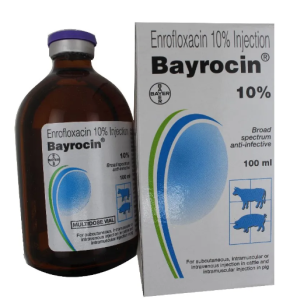
Enrofloxacin is also available as an injectable solution. A veterinarian administers the enrofloxacin injection, typically in vials or ampules containing a specific medicine concentration.
Oral Liquid
It may be available as an oral liquid or enrofloxacin suspension. It’s an enrofloxacin benefit because these formulations are convenient for oral administration, especially in cases where precise dosing is required. Buy enrofloxacin oral liquid 10% for cats and dogs with a calibrated dropper or syringe to accurately measure the dosage for administration.
Resistance to the Enrofloxacin
Over time, bacteria can develop resistance to Enrofloxacin and other antibiotics. It’s important to note that the development of resistance is a natural evolutionary process for bacteria. Misuse or overuse of antibiotics can accelerate the emergence and spread of resistant bacteria. Responsible antibiotic use, adherence to proper dosage and treatment duration, and the guidance of healthcare professionals or veterinarians are crucial to mitigate resistance.
Uses of Enrofloxacin
So what is Enrofloxacin used for, and what does Enrofloxacin treat? It is primarily used in veterinary medicine to treat bacterial infections in animals. Here is a breakdown of the common uses of Enrofloxacin for specific animals.
Bayrocin for Old and Young Dogs
What is Enrofloxacin used for in dogs? A veterinarian may prescribe it to treat dog bacterial infections, including respiratory, urinary tract, skin, and gastrointestinal infections.
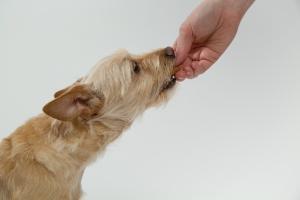
Enrofloxacin for Cats
What is Enrofloxacin used for in cats? It can be used in cats to treat certain bacterial infections, although it may be less commonly prescribed than other antibiotics due to potential side effects.
Medication for Birds
Enrofloxacin for bids can treat bacterial infections, such as respiratory infections or infections affecting their gastrointestinal or urinary systems.
Tablets for Horses
Enrofloxacin is occasionally used in horses to treat specific bacterial infections, but its use in horses is relatively limited compared to other antibiotics.
Enrofloxacin for Chickens
It is sometimes used in poultry, including chickens, to treat respiratory or gastrointestinal bacterial infections.
Pills for Rats
The medicine is occasionally prescribed for rats to treat bacterial infections, although other antibiotics are commonly used for small animals like rats.
Enrofloxacin for Cattle
Medication is used in cattle to treat respiratory, urinary tract, and other bacterial infections. However, its use in food-producing animals may be subject to specific regulations and withdrawal periods.
Bayrocin for Fish
Enrofloxacin is sometimes used in aquaculture to treat bacterial infections in fish.
Medication for Poultry
Enrofloxacin can be used in poultry, including chickens and turkeys, to treat various bacterial infections, such as respiratory or enteric infections.
Pills for Hamsters
The medicine is occasionally prescribed for hamsters to treat bacterial infections, but it is not the first-line antibiotic choice for these small animals.
Enrofloxacin for Humans
Enrofloxacin is not approved for human use in most countries, as other fluoroquinolone antibiotics are more commonly used to treat human infections. Instead, it is primarily intended for veterinary use.
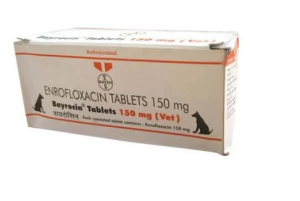
How and How Long Can Enrofloxacin Be Used for Animals?
The dosage of Bayrocin is determined based on factors such as the animal’s weight, age, and the specific infection being treated.
The duration of enrofloxacin treatment can vary depending on the type and severity of the infection. In some cases, treatment may last for a few days, while in others, it may extend for several weeks. It is essential to complete the entire course of treatment as prescribed, even if the animal’s symptoms improve before the treatment is finished. Prematurely discontinuing the medication can contribute to the development of antibiotic resistance.
Regular follow-up visits with the veterinarian may be necessary to monitor the animal’s response to treatment, adjust the dosage if needed, and assess for potential side effects or complications. The veterinarian will determine the need for follow-up based on the specific condition being treated.
Here’s a table describing the general usage of enrofloxacin tablets in 50mg and 150mg strengths for dogs and cats:
| Animal |
Enrofloxacin Tablet Strength |
Recommended Dosage |
Administration |
|
Dogs |
50mg |
Typically 2.5mg – 5mg per kg of body weight once daily or divided into two doses |
Administer orally with or without food. Follow veterinarian’s instructions regarding food intake. |
|
150mg |
Typically 1.25mg – 2.5mg per kg of body weight once daily or divided into two doses |
||
|
Cats |
50mg |
Typically 5mg – 10mg per kg of body weight once daily or divided into two doses |
Administer orally with or without food. Follow veterinarian’s instructions regarding food intake. |
|
150mg |
Typically 1.7mg – 3.3mg per kg of body weight once daily or divided into two doses |
Please note that the dosages provided in the table are general guidelines. Consult a veterinarian for the precise dosage and administration instructions for Enrofloxacin based on the individual animal’s needs.
Administering of Enrofloxacin Depending on Food Intake
How to dissolve Enrofloxacin? Bayrocin can be administered to animals with or without food, depending on the specific instructions provided by the veterinarian or the product label. The decision to administer medication with or without food may depend on factors such as the animal’s species, the formulation of the medication, and the potential impact of food on drug absorption.
In some cases, veterinarians may recommend administering Bayrocin on an empty stomach to optimize absorption. This is particularly important for certain species, such as dogs, where food can potentially interfere with the absorption of the medication. In such cases, Enrofloxacin is typically administered at least one hour before or two hours after a meal.
However, in other situations, veterinarians may advise administering the medicine with food to help minimize potential stomach upset or gastrointestinal side effects.
Administering the medication with food can help reduce the likelihood of
gastrointestinal irritation and may be more suitable for animals prone to
stomach sensitivity.
Side Effects
Bayrocin, like any medication, can cause side effects in animals. While not all animals will experience side effects, being aware of possible adverse reactions is essential. Here are some of the side effects associated with enrofloxacin use:
- Gastrointestinal Effects: diarrhea, vomiting, and, occasionally, constipation. These effects may be mild or transient in many cases but can occasionally be more severe.
- Kidney and Urinary Effects: Enrofloxacin can cause kidney damage or kidney failure, especially if given at high doses or in animals with pre-existing kidney disease. It’s important to monitor renal function during treatment and adjust the dosage as necessary.
- Neurological Effects: Although rare, Bayrocin can potentially cause seizures in susceptible animals. If a seizure occurs, veterinary attention should be sought immediately.
- Incontinence: Can Enrofloxacin cause incontinence? Some animals may experience temporary or prolonged incontinence, manifesting as involuntary urination. This side effect is typically reversible once the medication is discontinued.
- Vision and Blindness: Enrofloxacin has been associated with rare vision-related side effects, such as retinal degeneration, which can lead to blindness. If any visual changes are observed, it is essential to consult with a veterinarian promptly.
- Generalized Weakness and Tiredness: Some animals may experience lethargy, weakness, or tiredness while on Bayrocin treatment. This side effect can vary in severity and may require veterinary evaluation.
If you notice any concerning symptoms or side effects in your pet while on Enrofloxacin, it is crucial to contact a veterinarian for further evaluation and guidance.
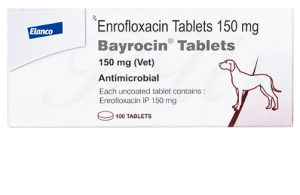
Overdose and a Maximum Daily Dose of Enrofloxacin
Overdosing on the medication can have severe consequences for animals. The specific maximum daily dose and the risk of overdose depend on the animal’s species, weight, overall health, and Enrofloxacin formulation.
Bayrocin overdose can increase susceptibility to side effects, including gastrointestinal disturbances, neurological symptoms, and potential kidney or liver damage. Overdosing can also contribute to the development of antibiotic resistance.
It is essential to consult a veterinarian regarding the appropriate dosage and administration of Enrofloxacin for a specific animal. Veterinarians consider various factors when determining the dosage, including the animal’s health status, the severity of the infection, and potential drug interactions. Veterinary guidance ensures the safe and effective use of the medicine while minimizing the risk of overdose.
If an accidental overdose is suspected or an animal exhibits symptoms of overdose (such as severe vomiting, diarrhea, seizures, or extreme lethargy), immediate veterinary attention should be sought. The veterinarian will assess the situation and provide appropriate treatment, which may include supportive care and management of symptoms.
Ototoxicity of Enrofloxacin
Ototoxicity refers to the potential for a medication to cause damage to the structures of the inner ear, leading to hearing loss or other auditory problems. While Enrofloxacin has been associated with ototoxicity in some studies, it is generally considered to have a low risk of causing this side effect compared to other antibiotics.
The incidence of Bayrocin-induced ototoxicity is rare and typically occurs at higher doses or with prolonged use. However, it is essential to note that the risk may vary depending on the animal species and individual susceptibility. In addition, factors such as pre-existing ear disorders, concurrent use of other ototoxic medications, and underlying health conditions can contribute to the potential for ototoxicity.
If you have concerns about the potential for ototoxicity with Bayrocin use in a specific animal, it is best to consult a veterinarian.
Storage
Bayrocin should be stored at room temperature, typically between 20°C (68°F) and 25°C (77°F). Avoid exposure to extreme temperatures, such as freezing or excessive heat, as it may affect the stability of the medication. In addition, it should be stored in a dry environment protected from direct sunlight. Storing it in a dark or opaque container can help prevent light-induced degradation.
Store enrofloxacin in its original packaging in a secure location inaccessible to children, pets, or individuals not authorized to handle medications.
Generic and Brand Names of Bayrocin (Enrofloxacin)
Enrofloxacin is available in both generic and brand name formulations. Here are some examples of generic and brand names of Enrofloxacin:
Generic Names
- Enrofloxacin
- Enrocin
- Enroflox
- Enroflor
- Enro-5
- Enroxil
- Enrox
Brand Names
- Baytril
- Bayrocin
- Veroflox
- Zeniquin (in combination with marbofloxacin)
- Quintor
- Enrocare
- Vetflox
- Enrosol
It’s important to note that the availability of specific brand names may vary depending on the country and the pharmaceutical companies that distribute Enrofloxacin. In addition, different formulations (such as tablets, injections, or oral liquids) may be marketed under various brand names.
Other Drugs in the Same Class
Enrofloxacin belongs to the class of antibiotics known as fluoroquinolones. Here are some other drugs in the same class that are commonly used for pets:
1. Ciprofloxacin is a fluoroquinolone antibiotic used in human and veterinary medicine. It is often prescribed for treating various bacterial infections in pets, including urinary tract infections, respiratory tract infections, and skin infections.
2. Marbofloxacin is a fluoroquinolone antibiotic formulated explicitly for veterinary use. It is commonly used in dogs and cats to treat urinary tract infections, skin and soft tissue infections, and respiratory tract infections.
3. Orbifloxacin is a fluoroquinolone antibiotic primarily used in veterinary medicine. It is prescribed to treat various bacterial infections in dogs and cats, including urinary tract infections, skin and soft tissue infections, and respiratory infections.
4. Pradofloxacin is a fluoroquinolone antibiotic explicitly developed for use in veterinary medicine. It is often used to treat bacterial infections in cats, including urinary tract and skin infections.
FAQ
Where to Buy Enrofloxacin for Dogs?
Enrofloxacin is a prescription medication typically available through veterinary clinics and pharmacies. First, consult a veterinarian who can prescribe and provide the appropriate dosage and formulation of Bayrocin for your dog’s specific needs. Then, check Enrofloxacin’s price and buy the cheapest Enrofloxacin for dogs online.
How Long Does It Take the Medication to Absorb?
The absorption time of Bayrocin can vary depending on factors such as the formulation (tablet, injection, oral liquid) and the individual animal’s metabolism. Generally, the medicine is well-absorbed after oral administration, and peak blood levels are usually reached within 1-2 hours.
Can the Tablet Be Crushed?
Crushing or breaking the tablets should be done only under the guidance of a veterinarian. Some tablets have a coating or specific formulation that ensures proper absorption, and altering the tablet may affect its effectiveness. Always consult with a veterinarian regarding the appropriate administration method for Bayrocin.
How Long Do Enrofloxacin Side Effects Last?
The duration of the side effects can vary depending on the individual animal, the specific side effect, and the dosage used. Mild side effects may resolve within a few days, while more severe or persistent side effects may require veterinary intervention and management. If you notice any concerning side effects, it is best to consult with a veterinarian for guidance.
How Long Does the Medicine Last Once Opened?
Once opened, the specific shelf life of Bayrocin may vary depending on the formulation and the manufacturer’s instructions. Therefore, follow the storage recommendations provided by the manufacturer or veterinarian to ensure the medication’s effectiveness and safety. If there are no specific instructions, it is advisable to consult a veterinarian or pharmacist regarding the shelf life of the opened medication.
Does the Pill Make Dogs Thirsty?
Increased thirst is not a commonly reported side effect of Bayrocin. However, animals may respond differently to medications, and individual reactions can vary. Therefore, if you notice excessive thirst or any other concerning symptoms after administering Enrofloxacin, it is recommended to consult with a veterinarian for further evaluation.
Can Enrofloxacin Be Used for UTI in Dogs?
Yes, Enrofloxacin is commonly prescribed by veterinarians to treat urinary tract infections (UTIs) in dogs. However, the specific diagnosis and appropriate treatment should be determined by a veterinarian who can assess the dog’s condition and prescribe the most suitable medication and dosage.
Does the Medication Treat Mycoplasma?
Enrofloxacin is effective against many bacteria, including some strains of Mycoplasma. However, the choice of medication for Mycoplasma infections may depend on the specific species and the sensitivity of the bacteria to Enrofloxacin or other antibiotics.
Is Enrofloxacin Good for Pink Eye?
Pink eye, also known as conjunctivitis, can have various causes, including bacterial, viral, or allergic origins. If the underlying cause of pink eye is a bacterial infection, a veterinarian may prescribe enrofloxacin eye drops or ointment as part of the treatment plan.

































